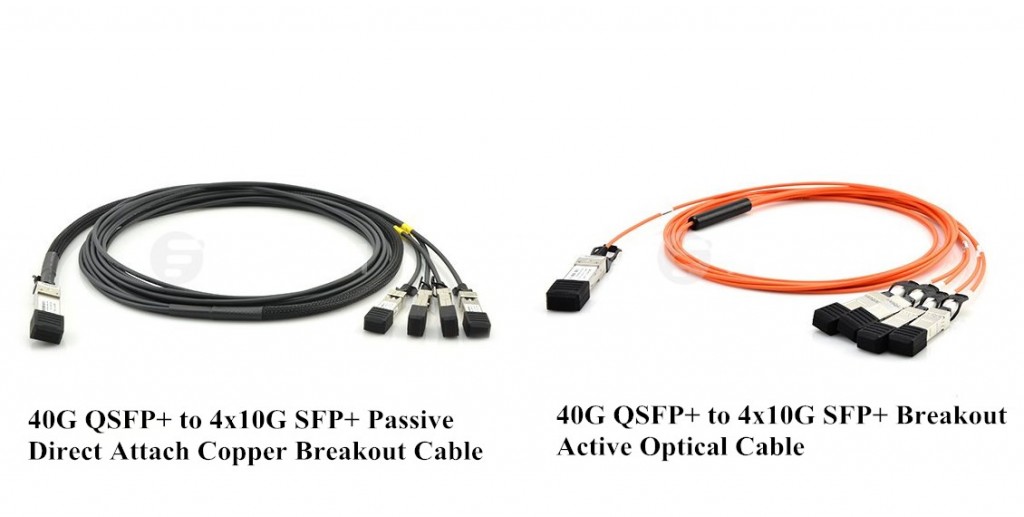April 18, 2016
The rapid growth of global regional and local fiber communication network over the past few decades contributes to a higher demand for cables which can provide lower-power means for high-speed and high-performance connections. Dirrect attach cable (DAC), is a cost effective and proven solution for interconnecting network applications. It can provide inexpensive and reliable connections using either copper cables or fiber cables. What is DAC? Here is what you need to know about DAC.
A direct attach cable is a fixed assembly which is purchased at a given length, with the connector modules permanently attached to each end of the cable. DAC is designed to use the same port as an optical transceiver, but compared with optical transceivers, the connector modules attached to the DAC leave out the expensive optical lasers and other electronic components, thus achieving significant cost savings and power savings in short reach applications.
Direct attach cables can be divided into different types according to different criteria. According to the cables used, direct attach cables include copper cable assemblies and fiber optic cable assemblies. Besides, according to the data rate supported by different connector modules, DAC assemblies can be classified into 10G SFP+ cables, 40G QSFP+ cables, and 120G CXP cables.
Direct attach copper cables can be divided into active and passive versions. In the active direct attach copper cable, there are signal processing electronics in the modules to improve signal quality and provide a longer cable distance. Otherwise, direct attach copper cable is considered passive. However copper cable is heavy and bulky, in order to overcome the disadvantages, active optical cable (AOC) assembly is booming in the market. AOC provides more advantages, such as lighter weight, high performance, low power consumption, low interconnection loss,etc.
And we can also divide DACs according to the number of connectors on the end of the cable. Most DAC assemblies have one connector on each end of the cable. But there is a special kind of DAC assembly which may have 3 or 4 connectors on one end of the cable. For instance, Cisco QSFP-4SFP10G-CU3M 40G QSFP+ to 4x10G SFP+ passive direct attach copper breakout cable, and Cisco QSFP-4X10G-AOC5M 40G QSFP+ to 4x10G SFP+ breakout active optical cable, as shown in the following picture, they both have a single QSFP+ connector rated for 40Gbps on one end and four SFP+ connectors, each rated for 10Gbps, on the other end.

There are 10G SFP+ cables, 40G QSFP+ cables, 120G CXP cables. Direct attach cable is used to connect one mobility access switch with another when forming a stack. To make sure they can function well, properly installation is needed. This part provides a DAC installation guide, using 40G QSFP+ cables as an example.
To Install or Rremove a 40G QSFP+ to QSFP+ Cable40G QSFP+ to QSFP+ cable has a QSFP+ module on each end of the cable. To install a QSFP+ to QSFP+ cable, first align the QSFP+ transceiver module (with the clasp on top) at one end of the cable with the port in the chassis, and then horizontally and gently push in the module to fully seat it in the port. To remove a QSFP+ to QSFP+ cable, first gently press and release the QSFP+ transceiver module, and then holding the cable, gently pull the clasp on the cable to pull out the transceiver module.
To Install or Remove a 40G QSFP+ to 4x10G SFP+ Cable40G QSFP+ to 4x10G SFP+ cable combines one 40G QSFP+ module on one end and four 10G SFP+ module on the other end. The installation and removal procedures of 40G QSFP+ connector are introdueced above. Here only introduced the installation and removal of 10G SFP+ module. To install an SFP+ transceiver, first align the module with the SFP+ port, with the golden plating facing the spring tab in the SFP+ port. If the chassis has two rows of ports, the spring tab in a port is on the bottom in the upper row and on the top in the lower row. Then slightly press the module against the spring tab so you can push the module straight into the port. To remove an SFP+ transceiver, first press the module with your thumb and then gently pull the clasp on the cable to pull out the transceiver module.
After the installation, remember to verify that the transceiver module or direct attach cable is installed correctly. Fiberstore provides various kinds of high speed interconnect DAC assemblies including 10G SFP+ cables, 40G QSFP+ cables, and 120G CXP cables. All of our direct attach cables can meet high demand to cost-effectively deliver more bandwidth, and can be customized to meet different requirements.
Posted by: jowang at
07:56 AM
| No Comments
| Add Comment
Post contains 790 words, total size 6 kb.
35 queries taking 0.0164 seconds, 70 records returned.
Powered by Minx 1.1.6c-pink.









